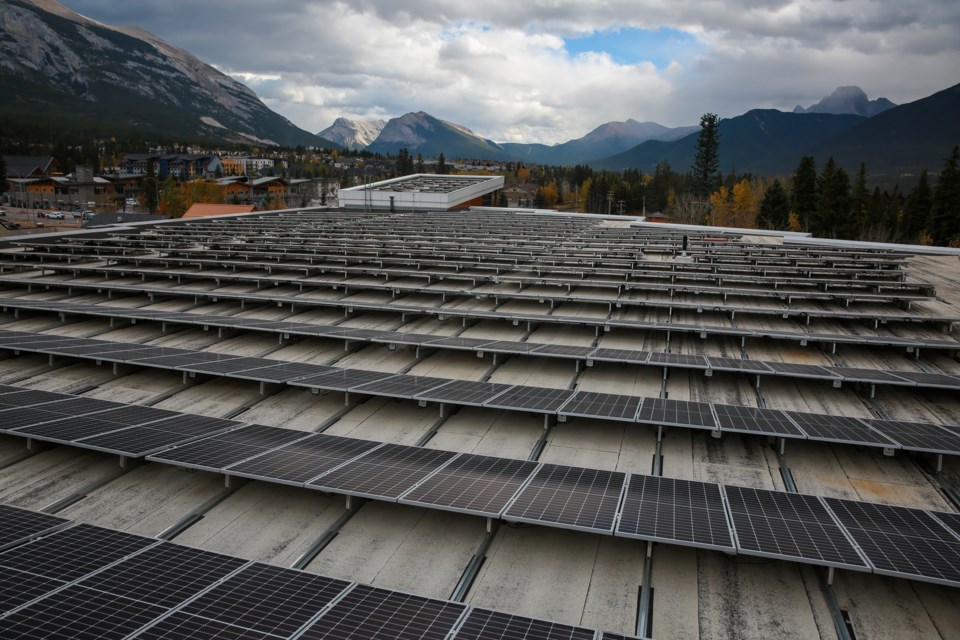CANMORE – New figures from the Town of Canmore show there could be more than 2,300 solar panels reducing 477 tonnes of greenhouse gas emissions on municipally owned buildings by the end of 2021.
The statistics were presented to Canmore council at its monthly committee of the whole meeting and showed the progress being achieved as the municipality aims to drastically reduce greenhouse gas emissions by 2030.
“Council has been very interested in sustainability initiatives, as are we, and it’s a great time in the era of sustainability to show the progress that’s been made,” Canmore’s manager of facilities Stephen Hanus said.
By the end of the year, the Town-owned buildings should be offsetting about 23 per cent of electricity and have an annual electricity savings of just under $44,000.
Hanus said all the projects have received about 30 per cent of the funding required through grants to offset the costs to municipal taxpayers. On buildings owned by the Canadian Rockies Public Schools (CRPS) division, there have also been roughly 1,800 solar panels installed, he said.
CRPS began installing solar panels on schools in 2010 and now generates more than 700,000 kilowatts an hour of annual electrical energy, ultimately reducing about 400 tonnes of CO2.
“This is a complicated issue and there’s budgets involved, resources involved," Hanus said. "We don’t have the land to do solar utilities. … You have to look at it from multiple perspectives.”
The Climate Adaptation and Resilience Plan was adapted in 2016, followed by the Climate Change Action Plan in 2018. The latter set goals to significantly reduce greenhouse gas emissions by 2030, such as community and corporate emissions.
Town council declared a climate emergency in 2019 and the Town’s 2019-22 strategic plan focused on minimizing the effect of climate change by reducing the area’s climate footprint.
“It’s really starting to translate into meaningful work,” Hanus said.
According to a comprehensive study completed by the Town and the University of Calgary, there’s a total of 1.273 million square metres on 6,345 buildings in Canmore to see the potential for rooftop solar panels.
“To me, that all speaks to rooftop solar potential,” Hanus said, highlighting more than 5,500 of those buildings are residential, but commercial, industrial, institutional and recreational comprise more than 300,000 square metres of rooftop.
“I think we can achieve community inroads faster if we target these three types (industrial, institutional and recreational) of building owners.”
The 82-page study noted a potential reduction of 40,072 tonnes of CO2 a year, which is the equivalent of taking 8,600 cars off the road, and generating 42,181 megawatts an hour per year to offset the electricity consumption by 64 per cent. It also listed 25 of the Town’s largest buildings as having about 10 per cent of roofs in the community.
“The potential is huge if we were to put solar on every roofline where it was suitable to do so,” Hanus said
The study highlighted the solar potential and suitability for areas in Canmore.
Hanus said the Town owns 94 buildings and six will have rooftop solar photovoltaic or thermal installations by the end of 2021, but noted solar and thermal projects have been ongoing since 2007. The first was the Senior’s Centre, but other large projects at Elevation Place, the Canmore Civic Centre and the Waste Management Centre followed suit.
He added roughly 93 per cent of greenhouse gases created by corporate-owned assets are from buildings, including 80 per cent from the wastewater treatment plan, the Canmore Recreation Centre, Elevation Place and the pump and lift stations.
Of the 94 municipally owned buildings, 34 are conducive to rooftop solar for a 3.4 megawatt of power for a 30 per cent reduction of electrical consumption and reduce 1,776 tonnes of CO2 each year, Hanus said.
“The goal is not to put solar on every facility. We should likely focus on our top three, five or 10, depending on our budgets moving forward. … We should focus what’s easiest to put on to get as many watts generated as soon as possible,” he said.





